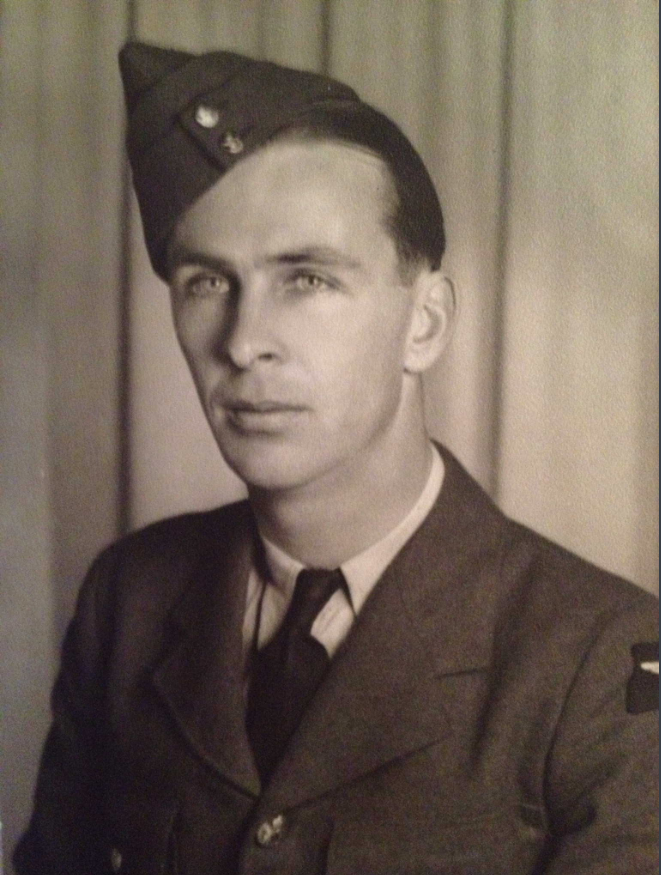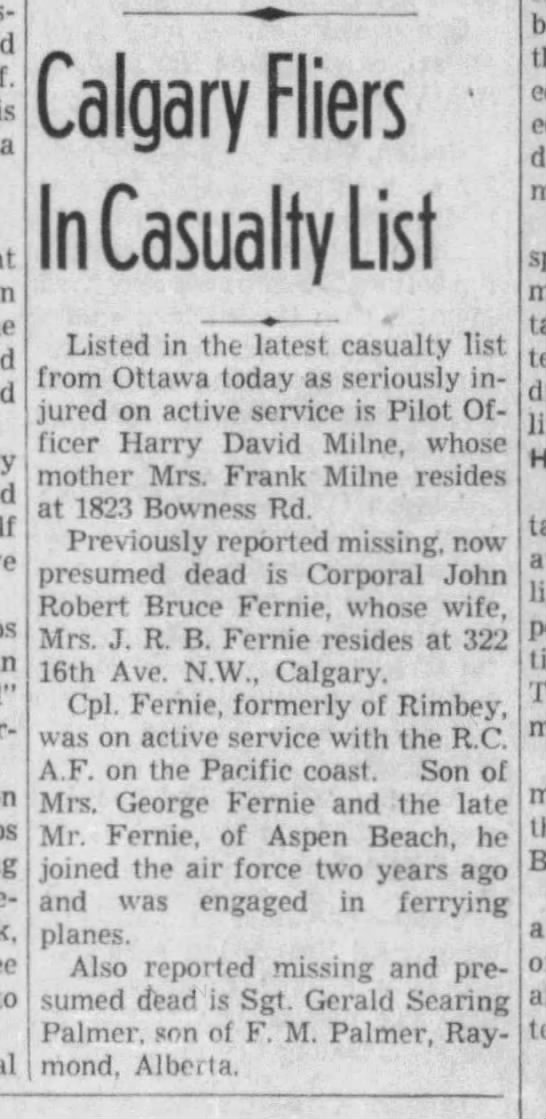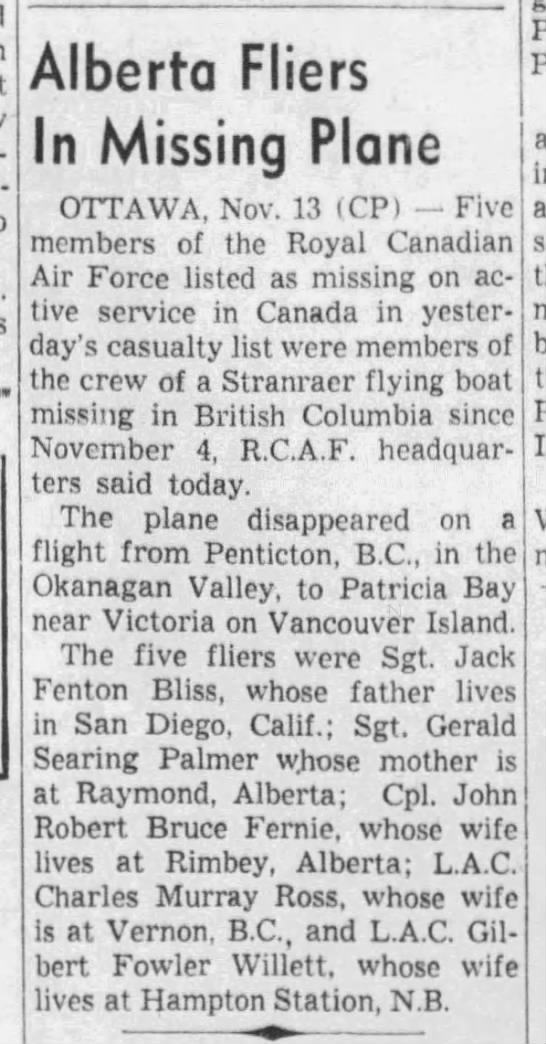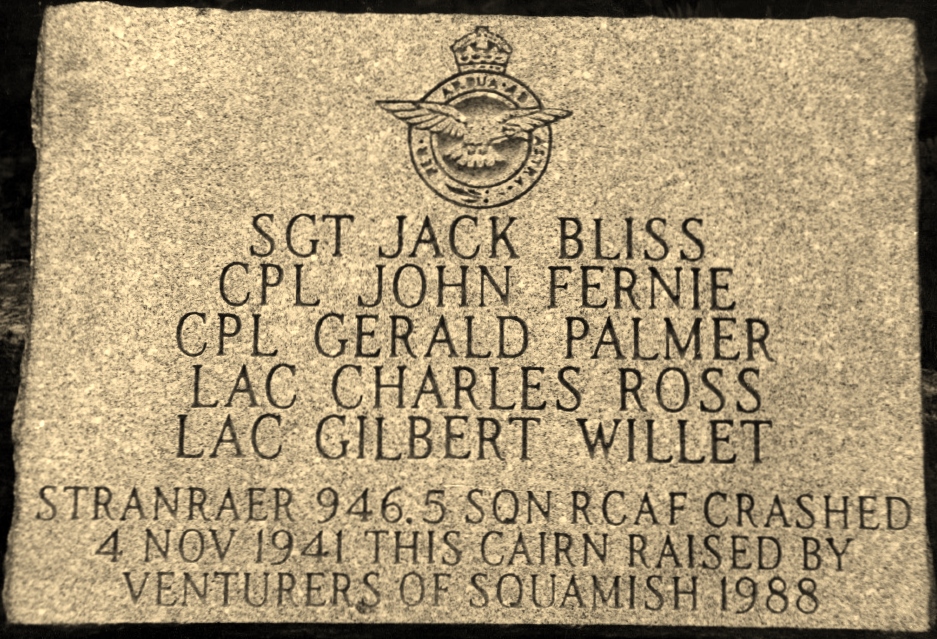




January 14, 1914 - November 4, 1944





John Robert ‘Bruce’ Fernie, born in Aspen Beach, Alberta, was the son of George Fernie (1873-1939) and Martha (nee Jeffries/Jaffray) Fernie (1884-1968). He had two brothers, Ernest Andrew (1917-1978) and Walter Weir (1922-1988). Ernie served with the RCAF, and Wally served with the Canadian Army. He also had three sisters: Mrs. Dorothy May Coll (1923-2021), Mrs. Rose Anderson, and Mrs. Jessie Gibbons (1915-2005). Dorothy served with the CWAC. The family attended the United Church.
He left school at the age of 15. He went to Edmonton Technical school, taking drafting, woodwork, and blacksmithing; he worked as a telephone messenger, truck driver, foreman of a small wood camp, a bartender, operated his own busines, and as a mechanic in Bentley, Alberta for James H. Hansen at his garage and service station for two years. After the war, Bruce hoped to remain in aviation with an airline or the RCAF as an aero engine mechanic.
Bruce married Violet Helen Heinz of Rimbey, Alberta in Edmonton on May 4, 1938. Bruce was 26 and Violet was 17 or 18. They had a son, Kenneth Nielson, born August 14, 1938. By September 1939, Violet and Bruce were separated. Violet had not been receiving payment of $67 (dependent’s allowance and assigned pay) and alimony was then established at this amount.
Bruce enlisted with the RCAF in Edmonton, Alberta, February 3, 1940. He stood 5’ 9 1/2” tall and weighed 138 pounds. He had blue eyes and dark brown hair. He liked hockey, baseball, softball, and tennis. “Good type of man; good general appearance.”
“Have several hours dual instruction, have taken in fairs with Lionel Vines who flew passenger hops; I took role of ticket salesman and grease monkey.” [Lionel Vines moved to Carcross, Yukon in December of 1936 to fly for Northern Airways (George Simmons). He was joined by his wife, Elaine, a month later. After a year, Lionel started to work for British Yukon Navigation Co. and flew for it until his plane went down near Dawson City on January 31, 1941. He is buried in the old cemetery in Whitehorse.]
Bruce started his journey through the BCATP at No. 1 Manning Depot, Toronto, Ontario February 7, 1940 until he was sent to TTC, St. Thomas, Ontario then to No. 2 SFTS, Uplands, Ottawa where he remained until he was sent to No. 5 BR Squadron, Dartmouth, Nova Scotia July 6, 1941.
On January 1, 1941, Bruce was reprimanded at No. 2 SFTS, Uplands, Ottawa, Ontario. “Being guilty of neglect likely to cause damage to His Majesty’s aircraft. Negligently failed to properly secure DZUS fasteners on Harvard 2258 and thereby caused damage to the port side cowling.” He was confined to barracks for three days.
In May 1941, Bruce asked that payment to his wife be discontinued and that the child’s allowance to be paid to his mother, Mrs George Fernie, as guardian of the child. (The divorce was not completed before Bruce’s death. Kenneth then lived with his maternal grandmother.)
In June 1941: “Very reliable, should make a very good NCO. Carried out duties as A/Cpl satisfactory manner. Recommended for Temporary Corporal.” In July 1941, he was assessed as an “average tradesman with no outstanding features. Is best suited for routine maintenance work.”
On November 4, 1941, Stranraer 946 was lost as the airplane and crew headed towards the BC coast from a stop at Penticton, BC hitting a snowstorm.
Crew: *Bliss, Jack Fenton, Sergeant, R58599, *Palmer, Gerald Searing, Sergeant, C4216 *Fernie, John Robert Bruce, Corporal, R50490 *Ross, Charles Murray, Leading Aircraftman, R65863 *Willett, Gilbert Fowler, Leading Aircraftman, R65048
On November 25, 1941, a letter, written by G/C F. V. Heakes for Chief of the Air Staff was sent to families of the men aboard Stranraer 946. “It is with deep regret that we have to advise you in reply to your letter of November 18, 1941, that the Stranraer aircraft in which your son…was lost while en route from Penticton BC to Patricia Bay, Vancouver Island, British Columbia is still missing…the journey on which the aircraft was lost was a very short one, particularly as the longest and most difficult part of the trip was from Ottawa had already been completed. The aircraft was in radio communication with the range to Hope British Columbia but lost communication at about that point. It was apparently later seen over Vancouver Island, only a short distance northwest of its final destination. During the time the aircraft was en route from Penticton, the weather on the coast had badly deteriorated and visibility had become very poor. For this reason, other aircraft of this type had returned to base and it would seem fairly certain that the aircraft seen was the one which is missing.
The aircraft carried fuel for a minimum range of 600 miles and for this reason search for it has proceeded a distance of several 100 miles up and down the British Columbia coast, all of the inlets and inland waterways and out to sea. Additionally, the search has covered the mainland, Vancouver Island, and the northern inland region of the United States. Not only have our own aircraft searched but the United States Air Service has have also assisted by having their aircraft cover wide areas for us. Naval vessels have also collaborated in the search. The search is still being conducted and every rumor is being followed up in the hope a successful end might be made to our efforts. The aircraft was new and in perfect condition, while the pilot was experienced on this type and had flown at operationally on the coast. Aviation has unhappily always presented those engaged in it with problems of this kind, and while every effort and precaution is exercised to ensure safety of personnel and aircraft, these efforts sometimes fail. Where they do fail, as in this case, it is natural that relatives of men missing should feel concerned as they ordinarily have little knowledge of the organization that exists to ensure safety of aircraft and to render aid when necessary. You may be reassured that no effort to discover this last aircraft has been or will be spared.”
In October 1947, the plane was located by prospector Basil Zurbriggen. [Interestingly, he had been considered missing in September 1947.]
Jerry Vernon, CAHS Vancouver Chapter President wrote on the RAF Commands Forum in 2011 indicating that a cairn was built at the site, approximately ten miles southeast of Squamish, British Columbia. The airplane flew into the hillside at the end of Indian Arm between Indian Arm and Squamish. “Any logging roads into the site were washed out long ago. The aircraft just caught the top of the ridge, otherwise they would have been over the top and looking at Howe Sound in the distance. There is a wooden cross at the crash site with the names of the crew, but vandals had partially burned it.” Details: “Reading some of the detail on 946....it had left RCAF Stn. Rockcliffe on 07 Oct 41. There was a change of pilot at Regina on 18 Oct 41, when F/O Coburn came down with acute appendicitis. Sgt. Jack Bliss took over as pilot. They landed at Brooks, Alberta, on 21 Oct 41 and bought gas from the Brooks Garage. One wingtip was damaged on the end of the CPR pier at Penticton on 23 Oct 41, and this took 12 days to repair. The aircraft departed from Okanagan Lake in poor weather on 04 Nov 41.
At 1300 hrs, the aircraft reported that they were ‘SE of Vancouver in the North Sector of the Princeton Range, flying blind and descending to try and make contact with the ground.’ They were advised to remain at 11,000 ft. until they had crossed the Vancouver cone marker. At 1346, the last radio messages from the aircraft said that ‘We are lost in a dense snowstorm over land and are nearly out of fuel. No position can be decided.’
A large scale search was conducted, particularly in the Port Alberni and Mount Arrowsmith areas [Vancouver Island], as an aircraft had been heard in that vicinity. The search was discontinued on 27 Nov 41.
The plane was found in heavy timber on 06 Oct 47 by an old trapper by the name of Zurbriggen. A cairn was erected, and a memorial service was held for the five lost airmen.”
In late October 1955, families received a letter from W/C W. R. Gunn, RCAF Casualties Officer, for Chief of the Air Staff who indicated that their sons did not have a known grave and their names would appear on the Ottawa Memorial.
On August 13, 1954, Bruce’s mother-in-law, received a pension for her grandson, Kenneth at $30.00 a month. She wrote a letter, “Dear Sir, Would like to thank you for the $30 which you send me every month for the care of my grandson, Kenneth N. Fernie, for it is the only income we get as my husband is sick in the sanitarium. And would it be right if you would send the month which Kenneth has coming from his father’s will, in my hands, instead of his mother’s (Violet H. Fernie). This would put Kenneth and myself out of luck.”
In late October 1955, families received a letter from W/C W. R. Gunn, RCAF Casualties Officer, for Chief of the Air Staff indicated that their sons did not have a known grave and their names would appear on the Ottawa Memorial.
On December 20, 1955, Mrs. Fernie, Bruce’s mother wrote to W/C Gunn. “I am writing to thank you for your kind letter which I received October 24 and I greatly appreciate your courtesy and kindness toward my son, John Robert Bruce, whose tragic death came so suddenly. I appreciate the honours and esteem being held for our boys who gave their lives by having their names inscribed on a War Memorial. I am hoping to be able to visit Ottawa in the spring before returning to my home in Calgary. I am at present, spending the winter with my daughter and son-in-law.”
In the spring of 1986, the Hellcat Venture Company erected a monument to replace the deteriorated cross. Money was raised to place a memorial plaque in 1988. In 2012, a book was published to commemorate the men lost aboard Stranraer 946. See links below.
LINKS: